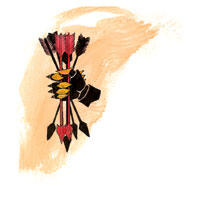Hextor
Pantheon: Oeridian
Origin of Worship: Oeridian
Core Worshippers: Oeridians
Common Worshippers: Others
Uncommon Worshippers: Others
Gender: Male
Rank: Intermediate deity
Areas of Concern/Portfolio: War, Discord, Massacres, Conflict, Fitness, Tyranny
Titles: Scourge of Battle, Herald of Hell
Holy Symbol: Fist holding six red arrows facing downward in a fan
Favored Weapon(s): Flail
Domains: Competition, Destruction, Domination, Evil, Law, Tyranny, War.
Induction Creed: "We came to the world dark and bloody. In everything, the strong rule the weak, and power is the only reward. Cruel and merciless are terms designed by the weak. Order must be forged and imposed, less chaos and anarchy reign. Tyranny is the path to survival. Dissenters are weaknesses, and like flaws in forged steel must be destroyed."
 Hextor
(HEKS-tor) dwells on the Planes of Acheron, but can wander to those of
Hell or even Nirvana. Most frequently, though, Hextor treads the Prime
Material Plane in search of warfare, aiding followers and disrupting the
plans of enemies. Especially does Hextor seek to overthrow those serving
Heironeous. Hextor is the arch-foe of Heironeous, his half-brother and
fellow Oeridian war god.
Hextor
(HEKS-tor) dwells on the Planes of Acheron, but can wander to those of
Hell or even Nirvana. Most frequently, though, Hextor treads the Prime
Material Plane in search of warfare, aiding followers and disrupting the
plans of enemies. Especially does Hextor seek to overthrow those serving
Heironeous. Hextor is the arch-foe of Heironeous, his half-brother and
fellow Oeridian war god.
Hextor is depicted in two forms. His first is a handsome man with jet black hair, dark eyes and fair skin. He is well spoken and charming, a hale fellow and a man's man, yet irresistible to women. He can converse with sages, reason with philosophers, argue with clergy, and discuss arcane secrets with dweomercraefters. When in his true form, however, Hextor is gray of skin, lank-haired, with red-rimmed eyes bulging from a visage horrible to look upon. Then he cares only to fight and slay. Since Hextor was always inferior to his half-brother, the Lords of Evil, an obscure force of supreme evil, fate, blackness, but also of balance granted Hextor six arms, instead of only a pair, so as to be able to best Heironeous and all other opponents.
In battle, Hextor draws two great bows which fire iron-barbed shafts. At close range he is often depicted employing two spiked bucklers and four weapons. Hextor wears armor consisting of iron scales with strips of metal at shoulder and cuff. A corselet of iron guards his waist and groin. His legs are greaved. This armor is everywhere decorated with skulls. Around his neck is the Symbol of Hate and Discord, the six red arrows of Hextor, hanging from a chain of crudely wrought iron links.
Hextor also often carries a magical artifact, the Trumpet of Acheron. This instrument can be winded once every six days. When sounded, it calls forth a legion of skeletal warriors, which obey Hextor's command. Once every six years, the Trumpet of Acheron can summon a terrifying horde undead from unknown blackness.
Hextor, Herald of Hell, Scourge of Battle, is the deity of many soldiers and fighters who admire war and discord. Hextor's clerics constantly train themselves in the arts of war, for they plan or lead attacks on rebels and enemies. Many serve petty or powerful leaders, and others still have achieved significant political positions of their own, particularly in the Great Kingdom. Individuals and small groups strike out from established churches to sow dissent in enemy lands; bringing down foreign nations from within so that the arms of Hextor may conquer.
Fortress-temples of Hextor are grim, dark, and austere. Major shrines and temples are often built on some field of slaughter or at mountain passes, river crossings, and other sites of strategic importance. They often have massive forges where they build weapons and armor for those aiding the cause of tyranny. His clerics wear black robes, adorned with white skulls or gray visages embroidered thereon. Only the higher-level clerics have arrows of hate and discord in red, lower-level clerics being permitted gray ones. Much chanting accompanies all ceremonies honoring Hextor. Wind instruments sound discordant tones, shouts and screams are voiced, and iron weapons are struck during such an offering.
Hextor's religion is organized in strict military style. Officers put recruits through rigorous and harsh training. Only those strong enough to put up with months of abuse become clerics of Hextor. Not surprisingly, they're eager to turn the tables and establish dominance over others. They establish themselves as the state religion wherever they can, join the crusades of despotic conquerors, and force local lords to kneel before them. Worshipers of Hextor generally express concepts as laws, such as "The slave shall not contradict the master, for such is the Law of Hextor." The hierarchical structure of Hextor worship lends itself to a number of rites that honor relationships between two unequal partners, such as master-slave or officer-soldier.